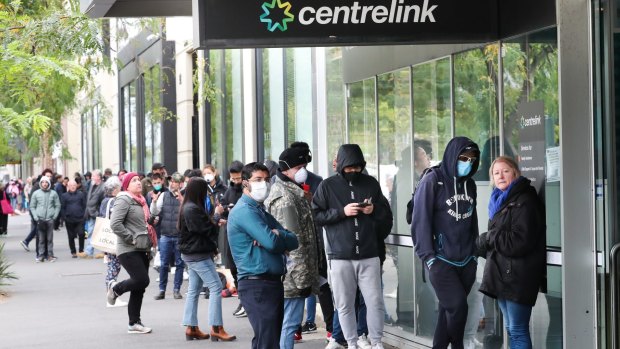This was published 3 years ago
Opinion
Meagre dole increase plays into tired old culture wars
Steven Hamilton
EconomistWhile welcome, the government’s $25-a-week dole increase sadly plays into the tired old culture war that’s hung over Australia’s unemployment benefit for decades.
With more than a million Australians on JobSeeker – many having never expected to find themselves in such a position – what we need is a wholesale rethink of both the substance of and rhetoric around the unemployment benefit in this country. But that won’t be easy.
The fact a highly electorate-attuned Prime Minister determined that even the most meagre dole increase needed to be paired with a beefing up of mutual obligations and the establishment of a dole-dobber hotline shows just how deep the resistance goes.

The dole is increasing by $25 a week, an amount that speaks to the difficulty of transcending old debates about unemployment benefits.Credit: Jason South
But we have to move beyond this old tug-of-war between work incentives and living standards, which is sure to leave nobody fully satisfied. There’s no reason this should be a partisan issue; everyone – recipients, employers, taxpayers, the broader economy – has something to gain from proper reform of our unemployment benefit system.
In normal times, Australia’s unemployment benefit provides just a third of the full-time minimum wage. But even at that meagre level, more than 700,000 Australians were on the dole heading into the crisis.
While there’s little doubt a very large increase in the long-term unemployment benefit would generate a disincentive to work, we’re nowhere near that level – even with the government’s announced increase.
If the existing supplement of $75 per week – triple what the government has settled on – were maintained, the payment would still only be around half the full-time minimum wage. That means seeking even the very lowest-paid job would double one’s earnings. It’s difficult to imagine such a level generating much additional disincentive.
And the announced changes fail to address a big problem with the existing arrangements, which is that the payment rises each year with prices rather than wages. This drives a wedge over time between the living standards of average Australians and the long-term unemployed, entrenching a permanent underclass of the permanently unemployed.
As a modern, civilised, wealthy nation, we need to be realistic about the role of our long-term unemployment benefit. Ultimately, a significant number of Australians will face insurmountable barriers to work that no financial incentive can overcome. Starving these people serves what end, exactly? If eliminating long-term unemployment is the goal, this strategy has failed.
What we should instead be focused on are proactive and creative measures to drive down the rate of long-term unemployment. And that can only be achieved via a total rethink of how we provide unemployment benefits.
While our unemployment benefit is only a third of the full-time minimum wage, it’s around the middle of the pack among wealthy, advanced countries in terms of its support for the long-term unemployed. Where the disparity is greatest is in fact at the short end – in the first three months of unemployment, Australia’s is the least generous payment of any advanced country on earth.
This is because we provide the same benefit regardless of how long a recipient has been unemployed. Very few other countries do it this way. Countries like Canada, the US, Israel, South Korea, not to mention all of continental Europe, offer instead a high initial payment that drops down to a lower level at a later date.
This relies on something economists call loss aversion – that the pain of losing something is greater than the joy from gaining it – to provide an added incentive to reenter the workforce. By providing a more generous payment initially with a clear end date, recipients are compelled by the future prospect of a reduced benefit to look for work.
But they’re also given the opportunity to do so. Instead of desperately accepting whatever job they can find, a more generous short-term benefit provides a recipient the resources to find a new job that fits them — and their employer. This has been found to lower turnover for businesses and reduce the rate of repeated unemployment spells, driving down long-term unemployment.
In a report released last week, the Blueprint Institute recommended such a scheme for Australia, to be called “JobMatcher”. This would be real insurance, providing 70 per cent wage replacement for six months to the newly unemployed. To pay for the scheme, it would be accompanied by real insurance premiums of 1 per cent of income.
By paying into the system, people earn the right to access it when they fall on hard times. Because an unemployment spell can happen to any of us, everyone who contributes also benefits.
The government is absolutely right on one thing – long-term unemployment in Australia is a big problem. But to tackle that problem, we need to recognise the folly of doubling down on a losing strategy.
What we need is an enlightened approach to the way we talk about and address unemployment in this country. Both an adequate standard of living for the long-term unemployed and a system of real unemployment insurance for the short-term unemployed is the right way to start.
Steven Hamilton is chief economist at Blueprint Institute and assistant professor of economics at George Washington University.
Business Briefing
Start the day with major stories, exclusive coverage and expert opinion from our leading business journalists delivered to your inbox. Sign up here.